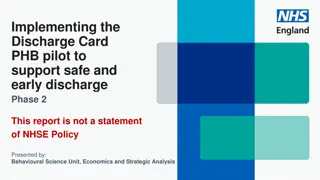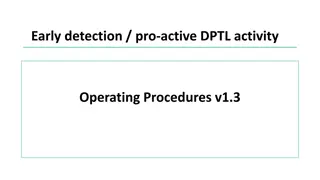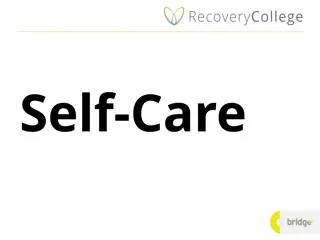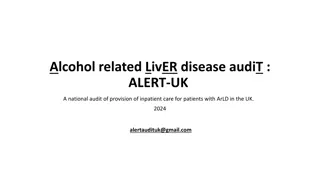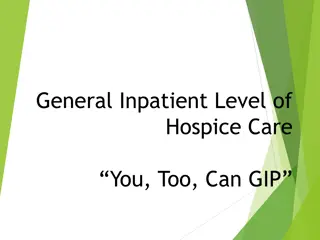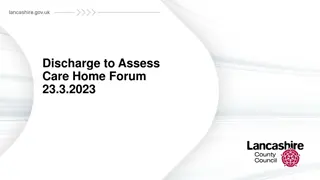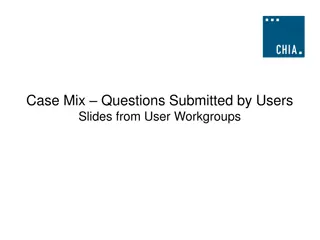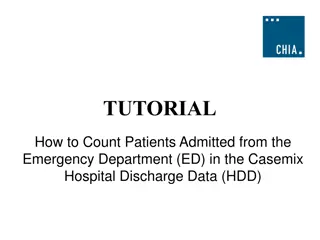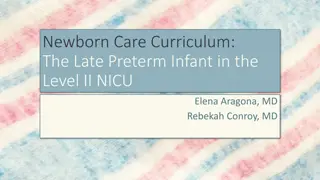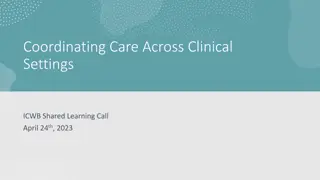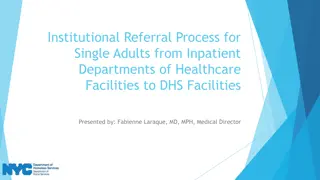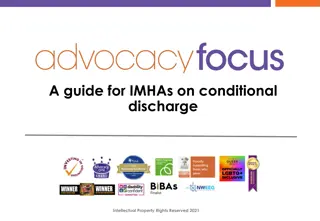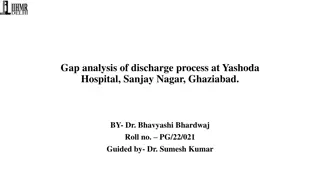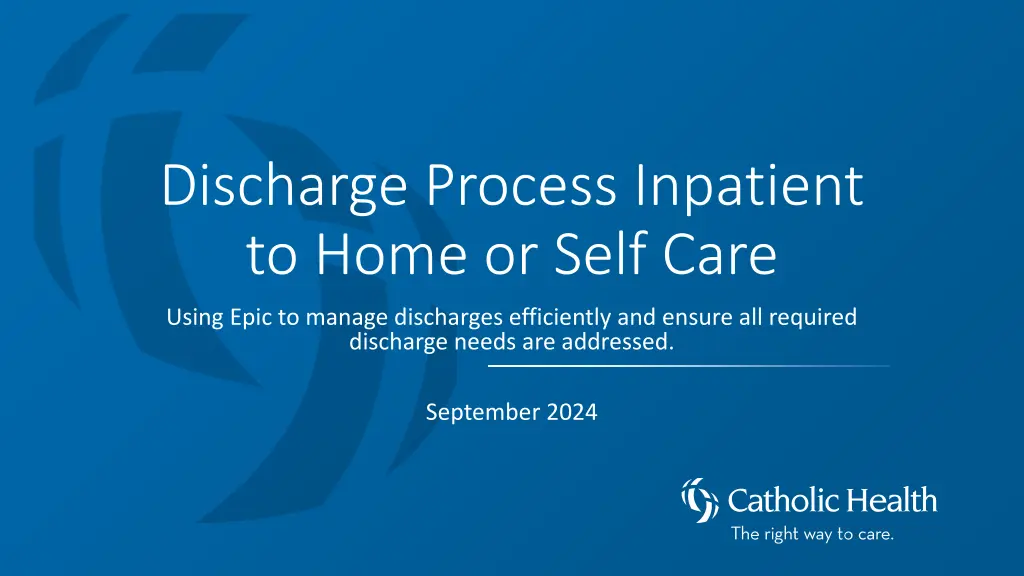
Efficient Inpatient Discharge Management Using Epic
Learn how to manage inpatient discharges efficiently using Epic software, ensuring all necessary requirements are met for a smooth discharge process. From placing discharge orders to providing post-hospitalization care instructions, this guide covers it all.
Uploaded on | 1 Views
Download Presentation

Please find below an Image/Link to download the presentation.
The content on the website is provided AS IS for your information and personal use only. It may not be sold, licensed, or shared on other websites without obtaining consent from the author. If you encounter any issues during the download, it is possible that the publisher has removed the file from their server.
You are allowed to download the files provided on this website for personal or commercial use, subject to the condition that they are used lawfully. All files are the property of their respective owners.
The content on the website is provided AS IS for your information and personal use only. It may not be sold, licensed, or shared on other websites without obtaining consent from the author.
E N D
Presentation Transcript
Discharge Process Inpatient to Home or Self Care Using Epic to manage discharges efficiently and ensure all required discharge needs are addressed. September 2024
Discharge Requirements per CHS Policy The provider order is necessary for a patient to be discharged from the hospital Medical Staff Responsibilities Instructions for patients being discharged to home can be given by a provider and will include Diet Activity Medication prescriptions Signs and symptoms to report to provider Follow-up appointment instructions Wound Care orders for patients with active wounds, pressure injury, lines or artificial airway Additional instructions If the patient is being discharged to another level of care (e.g. rehab, SNF etc.), a Discharge / Transfer summary or additional required forms should be completed (EMTALA, Ambulance Transfer, etc.) Table of Contents Table of Contents
Lets deal with that computer and Epic I need to place all my discharge orders and make sure my patient can take care of themself at home. How do I do this in Epic? Table of Contents Table of Contents
Table of Contents Patient has been determined clinically ready for discharge Using the Discharge Navigator Entering the Discharge Orders Searching DME for diabetic patients Problem List Adding Instructions for post hospitalization care Creating a pending discharge Adding a discharge summary Reviewing and validating all orders and information Table of Contents Table of Contents
Discharge Navigator Use the Discharge Navigator appropriate for the discharge Discharge tab This is for most discharges and the focus of this presentation Discharge/Readmit tab is for patients going to another CHS Facility a.Note: when a patient is being discharged to another CHS facility (like transfer for specialty service or MRU) Epic is looking for reconciliation to be done here and staff will not be able to print AVS until completed. If you believe this is in error, confirm disposition on the discharge order Discharge Deceased tab is for expired patients a.The key for this is the death date and time b.Review and update the Death of a Patient section c.No discharge order is needed d.Medication reconciliation is not required Table of Contents Table of Contents
Discharge Navigator Use the index of the Navigator and review/complete each section Ensure all orders are cosigned the admission order must be cosigned by a Physicianbefore a discharge order can be placed. Ensure no inappropriate signed and held orders remain for the visit address these by discontinuing those that are no longer needed. Any orders in this state that should have been carried out and were not should be brought to the attention of the nurse for follow up. Table of Contents Table of Contents
Patient Directed Discharge (PDD) - Definitions Some patients will request/insist on discharge or just leave the hospital without collaborating on the discharge process - even though the provider feels they should not leave. This group encompasses several different situations, all of which are referred to as Patient Directed Discharges rather than the prior derogatory terminology Against Medical Advice (AMA). Types/subtypes include but are not limited to: 1. Provider does not agree that the patient is medically appropriate to be discharged at this time, but the patient is still insisting on discharge despite clear discussion of risks of discharge 2. Patients who abscond and are not involved in discussions about discharge Table of Contents Table of Contents
Patient Directed Discharge (PDD) - processes Absconding patients clearly document in the chart what occurred, try to contact patient as well as HIPAA-authorized patient contacts using any contact information available in the chart. Additionally try to contact outpatient provider when there is an identified provider. Document those contact efforts and the results of those efforts. For all other Patient Directed Discharges, use the same tools as you would for any other discharge to home or self care. Provide post hospitalization discharge instructions, including: diet, activity, signs and symptoms to report to provider, follow-up appointment instructions and wound care orders for patients with active wounds, pressure injury, lines or artificial airway Perform discharge medication reconciliation and ePrescribe any appropriate medications Clearly identify in your discharge note and summary the risks and benefits of the patient directed discharge that have been explained and reviewed with the patient. Table of Contents Table of Contents
Patient Directed Discharge - cautions Signing AMA forms - this process is typically confrontational and pejorative, however an attempt should be made to have the patient sign these forms in a collegial and non-confrontational fashion. If the patient declines to sign, then document the effort and continue the discharge process Safety - Any PDD patient that is thought by medical staff or hospital associates to pose a hazard in the community such as driving in an unsafe condition should trigger notification to local law enforcement for intervention. Competency Refer to policy # CHS-LS-RSK-023 for details regarding any patient demonstrating mental lack of capacity Table of Contents Table of Contents
Lets deal with that computer and Epic Is there an easy way to place all my orders for post hospitalization care? Table of Contents Table of Contents
Discharge Reconciliation This area of the record must be completed accurately to ensure a proper med list for the patient appears on their after visit summary (AVS) Address any changes to medications when reviewing the home medication list Add any additional medications to be ePrescribed When performing medication reconciliation pay attention to start/stop dates for medication orders. Medications that are expired will not flow to downstream systems as expected and may cause confusion for patients after discharge. Reminders to patient to communicate with their PCP may be required. Table of Contents Table of Contents
Where is my discharge order??! CHS Discharge Order Set The actual order for discharge is being moved into the CHS Discharge to Home order set to help providers to ensure all policy requirements are met. This has not changed for procedural workflows. Select the orderset that is prompted GEN Discharge: Home or Self Care The mandatory sections in the order set will help ensure the appropriate discharge orders are placed Enter the desired discharge orders using the order set Be certain to address any post hospitalization care needs including wounds, incisions and pressure injuries, referrals Be sure all medications are updated and reviewed Table of Contents Table of Contents
Discharge Order Set from Navigator Table of Contents Table of Contents
Lets deal with that computer and Epic What about Durable Medical Equipment and supplies? How do I do this in Epic? Table of Contents Table of Contents
DME Supplies Adding DME orderables at the time of discharge will place these items as outpatient orders for the patient to use after their visit. (walkers, beds, diabetic supplies etc.) You will need to work with the case manager to ensure some of the items for home needs are ordered and delivered You may need to work with wound advisors for patients with complex skin care needs to ensure all dressing needs are ordered Table of Contents Table of Contents
DME Diabetic Supplies Be sure you are logged in to your appropriate hospital virtual department Search for the brand name of the product example: Verio When you search for a synonym you may receive the generic list and will need to search through for brand name products you want to order; any item with AKA in the name is dispensed as generic from the community pharmacy Be sure Dispense as Written is selected on your order Table of Contents Table of Contents
Additional Orders When you are in the discharge navigator order section and are placing any follow up orders for tests or procedures they will appear on the AVS if placed while you are in the discharge navigator Actively using the discharge navigator gives these orders a phase of Discharge Orders Search and add any additional orders for the patient to follow post hospitalization Table of Contents Table of Contents
Lets deal with that computer and Epic Why, why, why do I need to deal with this problem list?! Table of Contents Table of Contents
Problem List The entries on the problem list are used to prompt diagnosis related items in the record Additionally the problem list follows the patient to our clinics and outpatient settings for continued care Ensure all problems are reviewed and updated Resolve problems that are no longer relevant Update problems that are not resolved Select Mark Reviewed button The problem list is also used by the coders to ensure proper billing Table of Contents Table of Contents
Lets deal with that computer and Epic What is this Instruction section for? Table of Contents Table of Contents
Instructions for Post Hospitalization Care Use the Instructions section to add any instructions that are needed for post hospitalization care and management This information will go to the AVS and the patient s MyChart. Select the green plus sign for suggested education topics that have standardized reference information and videos for the patient to watch, when adding videos the patient will receive a QR code to scan with their device to view videos You can search for additional topics using the Clinical References hyperlink Use the free text section for additional information Can use a smart text/smart phrase here Can free text and use Dragon here Scan QR to View Table of Contents Table of Contents
Lets deal with that computer and Epic Can I prepare a patient for discharge ahead of time? How do I do this in Epic? Table of Contents Table of Contents
Preparation for Discharge things to consider You can create your discharge order and perform medication reconciliation in advance of expected discharge date up to 48 hours in advance. It is advised that caution be used when doing this any subsequent medication orders would need to be addressed in med rec on the fly. (Med Rec on the Fly document can be found on the Learning Home Dashboard.) The discharge order would be active and in place for all clinical staff. Enter the expected future date/time of the discharge on the order. An active discharge order must be present to perform med rec on the fly. Table of Contents Table of Contents
Preparation for Discharge things to consider Cont d. You can prepare discharge orders in advance of the discharge without restriction as long as the orders are in a pended state. The medication reconciliation would not take place at this time. The next provider entering the discharge navigator would see and be able to release the work already set up and would become the author of that work. This is invoked by selecting Save Work Complete Later Any authorized provider can review and release your pended discharge orders. Note: Future outpatient orders can be placed early on the Manage orders activity, reconciliation should not be done early as that sends information out to the community pharmacy as soon as it is completed. Table of Contents Table of Contents
Discharge Summary The discharge summary can be initiated by Provider A. The provider creating the discharge summary selects Share on the bottom of the note. On the day of discharge Provider B can edit the discharge summary and becomes the owning author of the discharge summary. The provider creating the discharge summary selects Share on the bottom of the note. Best Practice is to use the CHS Discharge Note Template Pulls in discharge orders placed on the patient Pulls in other patient specific information into the note Table of Contents Table of Contents
Lets deal with that computer and Epic What is an AVS? How do I know that the discharge orders are reflected appropriately in the chart and are available for the patient? Table of Contents Table of Contents
Validating Discharge Orders An AVS is the After Visit Summary provided to the patient on paper and in MyChart telling them how to care for themselves after discharge Click on the AVS button to preview the information being sent to the patient The AVS generated is specific to the patient type (medical, surgical, outpatient ) The RN will review all this information with the patient, family and/or caregiver and ensure all understand the information The information on the final AVS is sent to MyChart for the patient to have access to at any time from their personal device All downstream systems will have access to the information they need You can also review the Order History using the filter for Discharge Orders Table of Contents Table of Contents
All done! On to the next patient! Table of Contents Table of Contents

